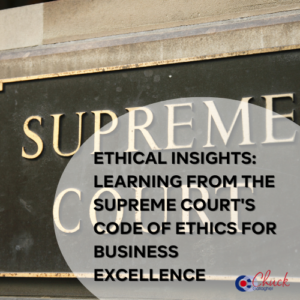 The recent unveiling of the U.S. Supreme Court’s first-ever code of ethics stands as a beacon, illuminating the path for businesses striving for ethical excellence. This groundbreaking development, a blend of legal understanding and moral guidance, offers a unique perspective for corporate leaders. It’s not just about adhering to the law; it’s about embedding a culture of integrity and accountability within the very fabric of an organization.
The recent unveiling of the U.S. Supreme Court’s first-ever code of ethics stands as a beacon, illuminating the path for businesses striving for ethical excellence. This groundbreaking development, a blend of legal understanding and moral guidance, offers a unique perspective for corporate leaders. It’s not just about adhering to the law; it’s about embedding a culture of integrity and accountability within the very fabric of an organization.
The Supreme Court’s code, while primarily designed for the judiciary, transcends its immediate realm, providing invaluable lessons for businesses. At its core, the code reflects a commitment to doing what is right, not just what is legal. It’s a subtle yet profound distinction that can redefine the ethical landscape of a corporation.
The Essence of an Effective Code of Ethics
A robust code of ethics is more than a set of rules; it is a declaration of an organization’s values and principles. Patricia Harned, CEO of the Ethics & Compliance Initiative, emphasizes that an effective code clearly communicates an organization’s commitment to ethical operations. It should outline the prohibitions and guide employees toward proper conduct, offering clarity on reporting suspected wrongdoing.
The Supreme Court’s Code: A Mixed Bag
The Supreme Court’s code, however, is not without its critics. An assistant professor of business law and ethics, Nicholas Creel, points out that the code’s introduction, which downplays recent scandals, might undermine its effectiveness. The document’s vagueness and lack of concrete consequences for noncompliance further dilute its potential impact.
Rabbi Yonason Goldson, an author on ethics, criticizes the code for being a mix of law, compliance, and ethics, noting that it fails to distinctly address the ethical aspect. The redundancy in stating that justices should respect the law underscores a missed opportunity to delve deeper into the moral dimensions of their roles.
The Challenge of Self-Regulation
Ben Michael, an attorney, highlights a critical challenge: the Supreme Court, like many organizations, faces the self-regulation dilemma. The effectiveness of any code of ethics hinges on its enforcement mechanisms. Without external oversight, the Supreme Court’s code risks becoming a mere formality rather than a transformative tool.
Moving Forward with Ethical Leadership
As envisioned by Cassandra Burke Robertson, a law professor, the path forward lies in the Court considering ethical issues institutionally rather than leaving them to individual justices. This approach could serve as a model for businesses: addressing ethical dilemmas collectively and transparently can strengthen the integrity of the entire organization.
Lessons for Business Leaders
- Commitment to Ethics: Emulate the Supreme Court’s commitment to ethics by embedding it in your organization’s culture.
- Clarity and Guidance: Ensure your code of ethics is clear, guiding both prohibitions and ideal conduct.
- Beyond Legal Compliance: Focus on ethical conduct that goes beyond mere legal compliance.
- Effective Enforcement: Develop robust mechanisms for enforcing your code of ethics.
- Collective Responsibility: Foster a culture where ethical issues are addressed collectively, ensuring transparency and accountability.
In conclusion, while the Supreme Court’s first code of ethics is a significant step, its true value for businesses lies in the lessons it imparts. By adopting a holistic approach to ethics, focusing on clarity, enforcement, and collective responsibility, businesses can elevate their ethical standards, ensuring compliance and a culture of integrity and trust.
For those seeking to delve deeper into the realm of ethics and AI or to explore how these insights can be integrated into your organization’s fabric, I invite you to reach out. Let’s embark on a journey towards ethical excellence together—contact Chuck Gallagher.


